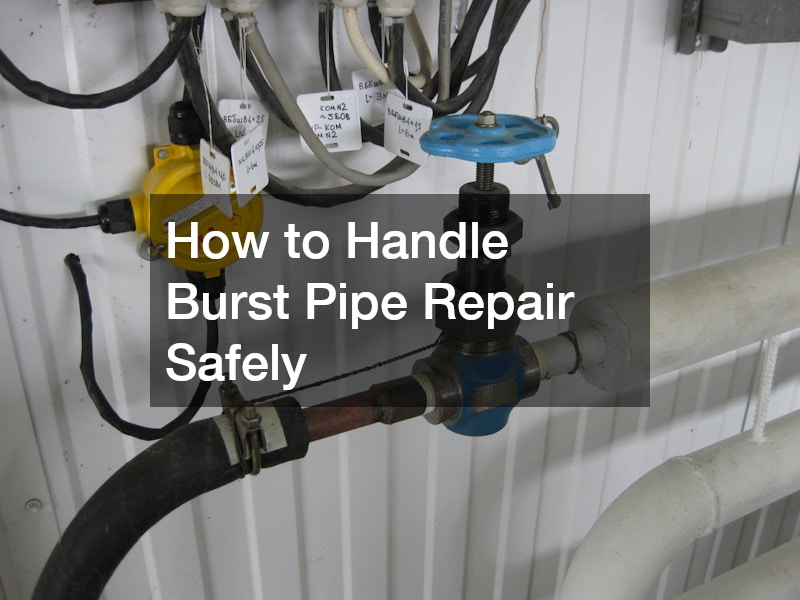
In this article, we will explore the essential steps and safety measures to take when dealing with a burst pipe repair. Understanding the potential dangers and necessary precautions can help prevent further damage and ensure your safety during the repair process. Burst pipes can cause significant water damage and incur high repair costs if not dealt with immediately and properly.
Video Source
Thus, having a clear approach can often make the difference between minor repairs and extensive restoration work.
When a burst pipe occurs, acting quickly is crucial. The first step involves turning off the main water supply to prevent further flooding. It is important to locate the main shut-off valve, which is typically found near where the water line enters your home. By shutting off the water, you significantly reduce the flow and volume of water that will cause damage.
Next, after the water supply is turned off, you should drain the pipes by turning on faucets throughout your home. This will help to remove any remaining water from the pipes, alleviating pressure and reducing the potential for additional leaks or bursts in the same area. Keeping the water drained minimizes loss and controls mess, making the following repair steps easier and safer.
Finally, assess the damage caused by the burst pipe. If water has accumulated in specific areas, it is vital to mop up or vacuum up as much water as possible to prevent mold growth and structural damage. Use towels or a wet/dry vacuum if available, and promptly begin drying out the affected areas. This process of mitigation is essential in preserving your home and belongings.
Understanding the underlying causes of a burst pipe can help prevent future incidents. Common causes include temperature fluctuations, corrosion, and high water pressure. Observing the conditions that led to the initial issue is paramount for developing an effective prevention plan. For instance, older homes may have aging pipes that are more susceptible to leaks and bursts.
Temperature changes can also significantly impact plumbing systems. When temperatures drop, pipes can freeze and expand, leading to cracks and eventually bursts. Homeowners should monitor external temperatures, especially during winter, and insulate vulnerable pipes in unheated areas like basements or garages.
Finally, high-water pressure can stress pipes beyond their capacity. It’s a good idea to regularly check your home’s water pressure using a pressure gauge. If it is above normal levels (generally above 60 psi), you may need to install a pressure-reducing valve to safeguard your plumbing system.
Safety is paramount when repairing pipes. Workers should don proper protective equipment to ensure safety from potential hazards. Essential items include safety goggles to protect your eyes from water splashes, debris, and potential chemical exposure from sealants or adhesives that may be used during the repair process.
Additionally, wearing gloves is crucial to protect your hands from sharp tools and the rough edges of pipes. Gloves also provide a barrier against potential contaminants and irritants present in water from the burst pipe. It is recommended to use waterproof or heavy-duty work gloves for optimal protection.
Lastly, sturdy shoes are essential during any repair work to avoid slips and falls amid wet conditions. Non-slip footwear can help prevent accidents while providing support and comfort as you navigate through repair tasks. Ensure that your clothing is also appropriate, avoiding loose fabric that might get caught in machinery.
Knowing when to seek professional help is important for ensuring safety and effectiveness in repair. If the damage from the burst pipe is extensive or if you feel overwhelmed by the repair process, you should not hesitate to reach out to a plumber. Professionals possess the necessary skills and tools required to handle complicated situations that may arise during repairs.
Additionally, if you are unsure of the cause of the burst pipe or if the damage occurs in a difficult-to-reach area, calling in an expert is advisable. Sometimes leaks can originate from hidden locations, such as behind walls or under floors, making it challenging for you to pinpoint the issue for DIY repairs.
Lastly, if you experience repeated bursts or significant issues that seem unresolvable, contacting a professional is crucial. Recurrent problems may indicate deeper plumbing system issues that need the insight and expertise of a licensed plumber. By doing so, you can save time and prevent further damage in the long run.
Handling a burst pipe repair safely requires prompt action, proper identification of the cause, appropriate safety measures, and knowing when to involve professionals. Such incidents can pose serious risks, but by following the guidelines discussed in this article, you will minimize risks and ensure a successful repair. Whether you're a seasoned DIY enthusiast or a newcomer to home repairs, understanding these key aspects will prepare you for dealing with the challenges of a burst pipe.
